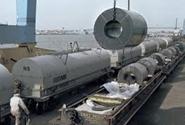Shipping and Logistics

November Logistics Report
Written by Sandy Williams
November 8, 2016
As we begin November and head into the winter season, SMU took a quick look at shipping conditions in the various transportation modes.
Seaborne
Stabilizing global steel prices and an increase in Chinese coal imports have helped seaborne freight rates rebound from their lows of early 2016. Vessel overcapacity continues to make any improvement in rates fragile, says MID-SHIP in their Nov. 3, 2016 report.
The Panamax average of the four time charter routes has moved to $7400 from $5600 since the start of October. Higher coal prices have increased shipments and have helped support supply and demand and spot prices. Capesize rates spiked at $15,000 in September and are now averaging $10,000 per day. The Supramax and Handysize markets have also improved and rates are holding steady.
The Baltic Dry Index registered 870 on Nov. 7 and has moved to 911 as of noon Nov. 8. The BDI tracks dry-bulk rates based on vessel size and shipping route and is a used as a benchmark for overall trade volume.
River
The Industrial Lock in New Orleans continues to be closed for maintenance but is on schedule to reopen December 6. The barge market is quiet and fairly flat right now, reports MID-SHIP. Rate increases related to the grain season have still not taken hold. Southbound grain freight rates were averaging near 350 percent of tariff as of the week ending November 1, 2016, down 32 percent from year ago levels.
![]() Trucking
Trucking
A new proposed regulation in the trucking industry would require all newly manufactured trucks over 26,000 pounds gross weight must have devices that would limit speeds to 60, 65, or 68 miles per hour. The American Trucking Association opposes the regulation saying it does not address “the differentials in speed that would exist between any of the three proposed national speed limits for trucks and the speed laws of multiple states – allowing passenger vehicles to travel at much higher speeds than commercial trucks.” The comment period has been extended on the proposed regulation.
DAT Trendlines reports that during the last week of October national spot market loads fell -3.6 percent from the previous week but were up 52 percent from a year ago. Spot market capacity was down 1.2 percent from the previous week and down -4.2 percent year-over-year.
Flatbed spot rates were up 0.5 percent in the week Oct. 23 through Oct 29 as a 1 cent increase in the national average fuel surcharge pushed the national flatbed rates up to $1.92 per mile. Rates ranged from $3.08 per mile in the Northeast to $1.50 in the Phoenix area. The national average fuel price for diesel was unchanged at $2.48 per gallon. Flatbed load posts declined 8 percent and the flatbed load-to-truck ratio for the period was 14.4 loads per truck.
Rail
Rail traffic in the week ending Oct. 29 was down 0.8 percent year-over-year to 544,977 carloads and intermodal units. The breakdown for the week was 271,576 carloads, down 2.8 percent and intermodal volume was 273,421 containers and trailers, up 1.3 percent from 2015. For October 2016, combined U.S. carload and intermodal originations were 2,142,814, down 3.2 percent or 70,896 carloads and intermodal units from October 2015.
“Railroads continue to face a difficult macroeconomic environment that’s negatively impacting their traffic volume,” said AAR Senior Vice President of Policy and Economics John T. Gray. “Grain is doing well and autos are hanging on, but many other commodity categories that depend on a vibrant industrial sector – things like steel, petroleum products, and crushed stone – are not doing as well as railroads would like. Hopefully that changes in the months ahead.”
Great Lakes
MID-SHIP reports that the cost of shipping on the Great Lakes could increase next year due to a U.S. Coast Guard proposal that would increase piloting costs by 17 percent. The American Great Lakes Ports Association opposes the increase citing double digit piloting increases in the past two years.
The National Weather Service is forecasting a relatively normal ice season on the Great Lakes this winter due to higher water temperatures. A La Nina trend is expected for the U.S. Ice normally begins to cause problems for shipping during the first week of January but mild fall temperatures could delay the start. The National Weather Service warns, however, “Relatively low ice formation on the Great Lakes will lead to the potential for the combination of increased storm activity and significant lake effect snow accumulation during the cold air outbreaks.” Significant snowfall creates hazardous conditions and delays for the trucking industry.

Sandy Williams
Read more from Sandy WilliamsLatest in Shipping and Logistics

Volvo plans to lay off up to 800 workers at US truck plants
The company cited uncertainty about freight rates and demand, regulatory changes and the impact of tariffs.

Trump signs executive order aimed at making US shipbuilding ‘great again’
President Trump on Wednesday signed an executive order meant to breathe new life into American shipbuilding and curb Chinese dominance in the sector.

Great Lakes iron ore trade fell again in March
Recall that shipments also saw a sharp decline in January.

Longshoremen ratify contract with maritime alliance
Nearly 99% of ILA members voted in favor of a new labor deal with the United States Maritime Alliance that covers workers at ports on the Atlantic and Gulf coasts.

Reibus: Flatbed rates up slightly but uncertainty ahead
With construction seasonally soft, the flatbed market remains softer than the other main trailer types.
